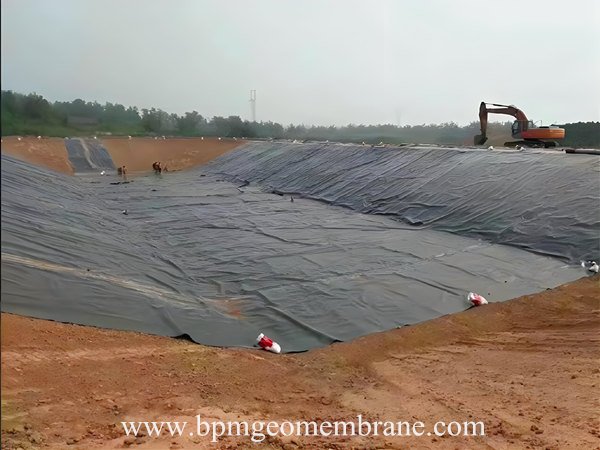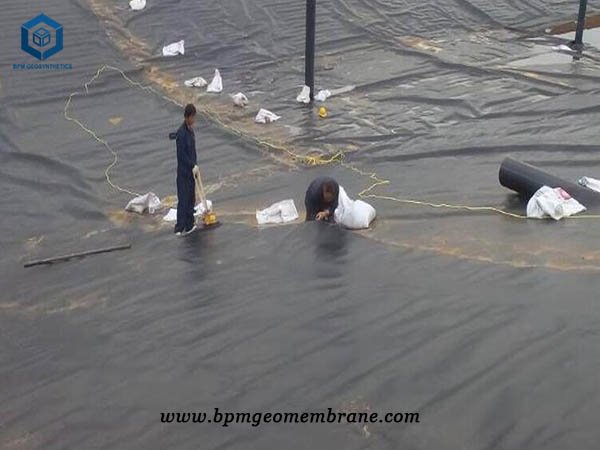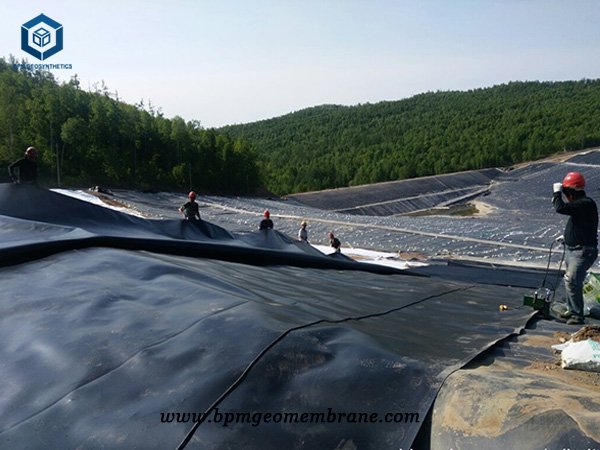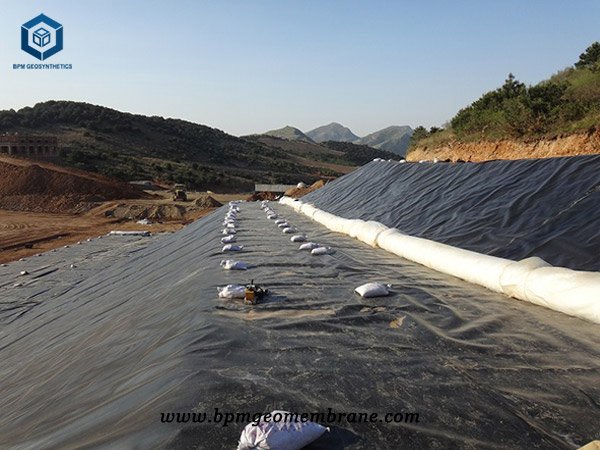HDPE Geomembrane installation, also know as geomembrane liner installation or geomembrane installation process, plays very important role in the anti-seepage ling system to prevent pollutants from waste or water containment applications. BPM Geosynthetics is thel leadinfg geomembrane manufacturer and supplier, we provide high quality geomembrane products and HDPE geomembrane installation service. In this article, we will explain the HDPE geomembrane installation process in detail.
1. What is HDPE Geomembrane?
HDPE geomembrane, also known as high-density polyethylene geomembrane, is a synthetic waterproof hydraulic barrier produced from high-density polyethylene resin with a density of 0.94 g/cm3 or more.
HDPE geomembrane is made from high-density polyethylene, a durable and impermeable plastic material. HDPE geomembranes are manufactured through an extrusion process, creating large sheets or rolls of the liner material.
HDPE geomembrane has excellent chemical resistance, UV stability, environmental stress crack resistance, low temperature resistance, aging resistance, corrosion resistance, and a large operating temperature range (-60 to +60 degrees) and a long service life up to 50 years. HDPE geomembrane puncture strength, abrasion resistance, toughness thickness are the key factors for geomembrane slection and installaton.
HDPE geomembranes come in various thicknesses, typically ranging from 0.5mm to 3mm or more, depending on the specific requirements of the project. Their versatility and reliability make them a popular choice for geomembrane applications worldwide. The commonly used geomembrane thickness on the market is 0.5mm, 1.0mm, 1.5mm, 2.0mm and 3.00mm. 1.5mm or 60mil thickness HDPE membrane is the widely used HDPE geomembrane. This HDPE geomembrane installation guide takes 60mil HDPE geomembrane as example.
2. What Are HDPE Geomembrane Used For?
There are many geoemmbrane brands on the market. Among them, XR 5 geomembrane, titan environmental geomembrane, GSE geomembrane, BPM geomembrane, solmax geosynthetics, argu HDPE liner are the best geomembrane liner on the global market. HDPE geomembrane liner has best physical and chemical properties than PVC liner, plastic liner, LDPE liner, etc.
The HDPE geomembrane liner is widely used for across a variety of industries including waste containment, water containment, aquaculture, industrial project, energy project and mining project, etc. HDPE geomembrane installation is complicated process that should be in accordance with ASTM or GRI standard. Improper installation will result in leakage or improper functions of geomembrane lining system. Generally, HDPE geomembrane installation is carried out by qualified engineers and technicians with welding and installing techniques, site preparation, and right installation steps, etc. In general, installation preparation, installation methods, site preparation, are 5 steps to ensure successful HDPE geomembrane installation.
3. What Is Geomembrane Installation
Geomembrane installation refers to the process of positioning impermeable liners or sheets to create a synthetic hydraulic barrier. Geomembranes serve a wide range of purposes, including the containment of hazardous waste byproducts, odor control, gas collection, preservation of potable water sources, aquaculture for food production, waterproofing dam faces, and controlling effluents.
During installation, the impermeable geomembrane liners or sheets are carefully placed to prevent the passage of liquids or gases. This process is commonly employed in diverse applications, including lining landfills, ponds, reservoirs, and other containment structures. By effectively creating a barrier, geomembranes contribute to the protection and management of various environments, ensuring the safe containment and control of substances and resources.


4. 5 Steps to Ensure Successful Geomembrane Installation
4.1 Preparation Before HDPE Geomembrane Installation
- Develop a HDPE geomembrane installation plan according to the geomembrane lining system design.
- Purchase high quality HDPE geomembrane products according to design requirements, especially the required specifications.
- Ground treatment. Carefully remove all sharp-edged hard objects on the ground that may damage the geomembrane, fill in the pits, level the soil surface or repair the slope surface.
- Installation environment requirements. The outdoor temperature is above 5 °C, the wind is below level 4, and there is no rain or snow.
- Geomembrane liner welding tools. The welding tools generally include HDPE liner welding machine, hot air welding gun, grinding wheel machine, vacuu tester, inflatable leak detectors: portable packing machine, and other accessories, etc.
4.2 HDPE Geomembrane Installation Methods
The installation of large areas of HDPE geomembrane should be carried out by tractors, hoists and other machinery. The condition does not have the small bundle of HDPE geomembrane liner, and it can also be artificially laid by geomembrane liner installers. The slanting machine for the slope surface is slowly spread from the top of the slope to the bottom of the slope, and the fixed groove is buried at the top of the slope and the bottom of the slope.
HDPE geomembrane laying in sections and blocks in the specified order and direction. Proper installation of HDPE geomembrane requires installers to lay it in sections and blocks following the specified order and direction. This approach ensures the integrity and performance of the geomembrane system. By adhering to the designated sequence and direction, installers can accurately position overlaps and seams, effectively managing stress and deformation during construction.
Dividing the geomembrane into sections and blocks allows for better control of flatness and tightness, minimizing errors and defects. It also enables adaptability to varying terrain and irregular construction conditions, enhancing installation accuracy and efficiency. Following the specified order and direction promotes consistency and overall performance of the geomembrane system, enhancing its impermeability and long-term stability. Therefore, adhering to the specified order and direction is crucial for installers to ensure the quality and reliability of the HDPE geomembrane installation.
Avoid hard bending and damage when installing HDPE geomembrane. When installing HDPE geomembrane, it is crucial to avoid hard bending and potential damage. Hard bending can lead to stress concentrations and compromise the integrity of the geomembrane, increasing the risk of leaks and failure. Installers should handle the geomembrane with care, ensuring smooth and gradual bends to minimize strain.
Additionally, proper equipment and techniques should be employed to prevent punctures, tears, or abrasions during installation. Implementing quality control measures, such as inspecting the geomembrane for any defects prior to installation, can help identify potential issues and ensure a successful installation. By prioritizing proper handling and avoiding hard bending, the longevity and performance of the HDPE geomembrane can be preserved.
It is essential for the geomembrane liner installers to adhere to the requirement that the geomembrane joint between modules should be T-shaped and avoid creating a cross shape. A T-shaped joint offers superior structural stability, ensuring a robust connection that minimizes the risk of leakage or failure.
By maintaining this design, stress distribution and load transfer along the joint are optimized, enhancing the overall integrity and performance of the geomembrane system. Conversely, a cross-shaped joint may introduce weak points and compromise the system’s effectiveness. Adhering to the specified T-shaped joint configuration promotes a reliable and durable geomembrane installation.


HDPE geomembrane weld joints shall be free from dirt, sand, water (including dew) and other debris that affect the quality of welding. The geomembrane liner installers should ensure HDPE geomembrane weld joints remain completely clean and free from dirt, sand, water (including dew), and other debris that could compromise the welding quality. These contaminants can impede the fusion process, resulting in weakened welds that may be susceptible to leaks and failures.
When installing 60mil or 120mil HDPE geomembrane on a sloped surface, it is crucial to consider the joint arrangement direction. The joints should be aligned parallel or perpendicular to the maximum slope line to ensure optimal performance. Additionally, the geomembrane should be laid in a specific order, starting from the bottom and progressing upwards. This sequence provides stability and prevents potential slippage or misalignment during installation. Adhering to these guidelines ensures proper alignment of the joints and promotes the long-term integrity and effectiveness of the HDPE geomembrane system on sloped surfaces.
The geomembrane liner and joints are properly and carefully applied to the slope. Precise application of the liner and joints guarantees a secure and effective containment system, mitigating the risk of seepage or leakage. By following proper installation techniques and paying attention to detail, the geomembrane system can maintain its integrity and provide reliable performance on sloped surfaces.
HDPE geomembrane is installed in a naturally loose manner, ensuring that the support surface is compact and free from pleats or suspension. The geomembrane installers carry out the proper adhesion and eliminates potential stress points that could compromise the integrity of the geomembrane. By maintaining a smooth and uniform contact with the support surface, the HDPE geomembrane can effectively perform its intended functions, such as providing impermeability and preventing the migration of contaminants.
4.3 HDPE Geomembrane Field Connection
Proper installation and integrity of the joint is a prerequisite for ensuring effective functions and longer service life of the HDPE lining system.
4.3.1 The connection of polypropylene geomembrane should not be carried out under bad weather conditions to ensure the quality of the connection.
4.3.2 In the case of heat sealing by HDPE liner welder, the phenomenon of overheating should be avoided to prevent foaming at the joint.
4.3.3 The adhesion between geomembranes of different raw materials should be avoided as much as possible. In case of unavoidable circumstances, special research should be carried out.
4.3.4 Polypropylene geomembrane welding method: hot wedge welding method, its advantages:
- It is not necessary to roughen the surface of the film. During the welding process, no new materials are added to form the weld.
- Its heat source control is separated from HDPE geomembrane. The welding form should be double welded, the line width is 12mm, and the second line is 10mm.
4.3.5 Wipe the weld joint with clean gauze to make it water-free, dust-free and dirt-free. The geomembrane should be aligned in parallel and the amount should be overlapped.
4.3.6 Welding quality control. Adjust the welding equipment to the best working condition according to the local climatic conditions and material properties at that time. Pay attention to the selection of temperature, speed and pressure during the welding process.


4.3.7 Firstly, a small sample welding test is carried out to test a 1 m long polypropylene liner sample, and the on-site tear test is used. The weld is not damaged by tearing, and the base material is considered to be qualified by tearing.
3.3.8 After the on-site tear test is passed, the formal welding is carried out one by one.
4.4 HDPE Geomembrane Welding Process
4.4.1 The HDPE geomembrane welding joint shall be carefully welded together seamlessly, and there shall be no voids in the weld joint due to lack of welding, leakage welding, scorching and damage.
4.4.2 The geomembrane welds must be cut during the field of virtual welding and leakage welding. Use a HDPE liner welding machine to repair the incision damage site with a base material that is more than twice the diameter of the damage.
4.4.3 The width of the double seam of the weld should be no less than 2mm×10mm.
4.4.4 The misalignment between transverse welds shall be greater than or equal to 500mm.
4.4.5 T-shaped geomembrane joints should be made of base material, the patch size can be 300mm × 300mm.
4.4.6 The two-layer HDPE geomembrane that is connected must be flattened and soothed.
4.5 HDPE Geomembrane Weld Quality Inspection
4.5.1 The detection method should adopt the inflation method, that is, the double weld pressure test method and the vacuum tank method, or the spark test or the ultrasonic probe method.
4.5.2 The testing equipment uses a pneumatic detector and a vacuum detector.
4.5.3 Weld quality requirements
- The distance between each section of the double-slit test is about 1.5mm-3mm. The pressure is controlled by 0.5MPa-2.0MPa according to the requirements of the geomembrane test procedure in accordance with ASTM or GRI. The time is no less than 30 seconds. If it is observed for more than 30 seconds, the gas is not Will leak, then the connection is considered qualified.
- For single welds and T-shaped joints and repair points, a 50cm × 50cm square shall be taken for vacuum test. The vacuum pressure is greater than or equal to 0.005MPa, and it shall remain for 30s.
- Laboratory test, the strength of the film and film weld joint shall not be less than 80% of the strength of the base metal (welding shear strength ≥ 80% of the tensile strength of the base metal)
4.5.4 The quality inspection shall be carried out at the same time as the construction progresses. The connection quality must be carefully checked at the joints. Those who fail shall be reworked resolutely.
5. Summary
The HDPE geomembrane installation process can be accomplished with a professional company or geomembrane liner installers. As the the professional geomembrane manufacturer and supplier, BPM has been dedicated to supplying one stop geomembranes and services to worldwide customers since its foundation in 2010. Our main innovative, high quality geosynthetics products include geomembranes, geotextiles, geocells, geosynthetic clay liners (GCLs), drainage boards, geogrids, etc. BPM has many years of experiences for qualified HDPE geommebrane installation service. Welcome to contact us for more information for HDPE geomembrane products and installation service.





